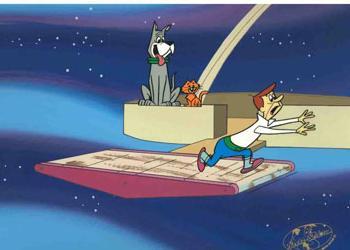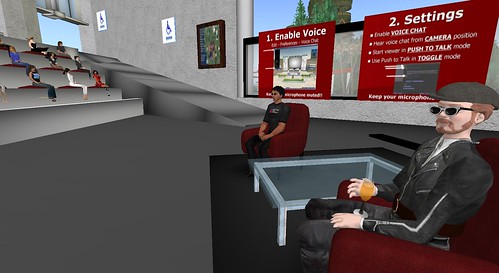How are we ‘written upon’ by our technologies and how can we avoid becoming Taylorized cogs in the rushing machine that is our culture?
You may not have time to read this, but if you seize it, you may find yourself in a new relationship with this valuable tool – a relationship that can decrease stress and increase creativity and even “productivity.” Now that we’re several centuries past the era when we began measuring ourselves and our accomplishments according to mechanized time, it may seem too late or perhaps even quaint to reconsider our relationship to this man-made technology, but such reflection may be just what we need to step off the Jetson’s treadmill and into a more humane and appropriately paced future.
“Help! Jane! Stop this crazy thing!!” – who is in control here?
In his 1936 essay “The Olive Tree” Aldous Huxley notes that time as we experience it is a “byproduct of industrialism” and he asserts that “time is our tyrant.” We might well consider how much we are tyrannized today with our gaggle of gadgets that help us to schedule and connect with one another with increasing precision, packing ever more activity into the same solar cycle. While we generally grasp the positive utility of our time management tools, we rarely if ever consider how an increasing attention to time can become an obsession that undercuts our performance and our enjoyment of daily experience through embodied stress and blockage of creative thinking.
When it comes to education, sufficient time is essential. Unlike job training centers that claim to be “educators” and who proudly proclaim they can bring a student from “zero to Bachelor’s in 2.5 years,” a genuine liberal arts education requires a bit more time and a whole lot more thought and effort. Even if or when it becomes possible to buy a university education that can be simply “downloaded” into a student, the time compression would equal an elimination of a variety of valuable experiences and the resulting intellect would necessarily be shallower.
Sufficient time for reading, conversation and sustained reflection are as necessary to an effective education as they are to good writing. Our thoughts and writing do not fully mature when we do not allow them enough time to grow. Here is where we can use the tool of time to our greatest benefit. Instead of jamming our schedules with activity, we can discipline ourselves to reserve plenty of “growth time” that allows sufficient leisure for ideas and creative expression to flourish.
When rush important experiences and we allow ourselves to be herded into a chronological panic, we overlook things like the strings that are attached, or we forget the subtle, steady and ancient clock of the Sun that reminds us of a more universal perspective and puts our lives and “accomplishments” in a more realistic context. May we learn from Macbeth’s unsatisfied ambition and not be that “poor player that struts and frets his hour upon the stage” but rather let us stretch out our hours together on this Earth to maximize the joy and brilliance of human intellectual exploration and creativity while we have the chance….mind your business, be here now.
For further inspiration to step off the Taylorized treadmill, check out Carl Honore’s 2004 book In Praise of Slowness.






 Whether distracted by digital devices, discouraged by poor teaching, few job prospects or simply misled by a culture that often undermines significant promotion of reading and writing, our students can arrive in our class alienated from language, incurious and expecting little to engage them. It is clear that reading of traditional typographic texts significantly enhances our ability for sustained, focused attention but it is equally clear that, in spite of the dominant authority of (not so)
Whether distracted by digital devices, discouraged by poor teaching, few job prospects or simply misled by a culture that often undermines significant promotion of reading and writing, our students can arrive in our class alienated from language, incurious and expecting little to engage them. It is clear that reading of traditional typographic texts significantly enhances our ability for sustained, focused attention but it is equally clear that, in spite of the dominant authority of (not so)  Location: Student WikiIn 2006, when I began reading about
Location: Student WikiIn 2006, when I began reading about  For
For  When
When  What
What  I caution writers from jumping to conclusions, preferring that they crawl to them after many observations. We need to continue this experiment, especially since Kiaarra Karillion, whose avatar is normally a black female, found that "with my African-American avatar, I rarely was offered packages (or much advice) from people on Second Life. During my completion of this project, I was offered packages [of freebies] from every direction!"So while no one had racial slurs hurled at their avatars, Kiaarra and more than a few of her classmates felt like Ralph Ellison's Invisible Man.Several students noted the dearth of ethnic skins, especially for men. I'm pleased that Linden Lab included a black man as their default "Professional Male" avatar. Perhaps Barack Obama's charisma may change real-world standards of what's considered attractive. My students will be back in SL in coming semesters, to see if Obama's victory changes hearts and minds online.
I caution writers from jumping to conclusions, preferring that they crawl to them after many observations. We need to continue this experiment, especially since Kiaarra Karillion, whose avatar is normally a black female, found that "with my African-American avatar, I rarely was offered packages (or much advice) from people on Second Life. During my completion of this project, I was offered packages [of freebies] from every direction!"So while no one had racial slurs hurled at their avatars, Kiaarra and more than a few of her classmates felt like Ralph Ellison's Invisible Man.Several students noted the dearth of ethnic skins, especially for men. I'm pleased that Linden Lab included a black man as their default "Professional Male" avatar. Perhaps Barack Obama's charisma may change real-world standards of what's considered attractive. My students will be back in SL in coming semesters, to see if Obama's victory changes hearts and minds online.